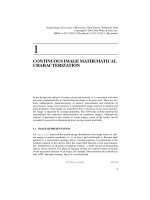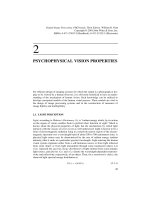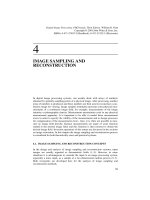Tài liệu Xử lý hình ảnh kỹ thuật số P9 docx
Bạn đang xem bản rút gọn của tài liệu. Xem và tải ngay bản đầy đủ của tài liệu tại đây (503.05 KB, 28 trang )
213
9
LINEAR PROCESSING TECHNIQUES
Most discrete image processing computational algorithms are linear in nature; an
output image array is produced by a weighted linear combination of elements of an
input array. The popularity of linear operations stems from the relative simplicity of
spatial linear processing as opposed to spatial nonlinear processing. However, for
image processing operations, conventional linear processing is often computation-
ally infeasible without efficient computational algorithms because of the large
image arrays. This chapter considers indirect computational techniques that permit
more efficient linear processing than by conventional methods.
9.1. TRANSFORM DOMAIN PROCESSING
Two-dimensional linear transformations have been defined in Section 5.4 in series
form as
(9.1-1)
and defined in vector form as
(9.1-2)
It will now be demonstrated that such linear transformations can often be computed
more efficiently by an indirect computational procedure utilizing two-dimensional
unitary transforms than by the direct computation indicated by Eq. 9.1-1 or 9.1-2.
Pm
1
m
2
,() Fn
1
n
2
,()Tn
1
n
2
m
1
m
2
,;,()
n
2
1
=
N
2
∑
n
1
1
=
N
1
∑
=
pTf=
Digital Image Processing: PIKS Inside, Third Edition. William K. Pratt
Copyright © 2001 John Wiley & Sons, Inc.
ISBNs: 0-471-37407-5 (Hardback); 0-471-22132-5 (Electronic)
214
LINEAR PROCESSING TECHNIQUES
Figure 9.1-1 is a block diagram of the indirect computation technique called gen-
eralized linear filtering (1). In the process, the input array undergoes a
two-dimensional unitary transformation, resulting in an array of transform coeffi-
cients . Next, a linear combination of these coefficients is taken according
to the general relation
(9.1-3)
where represents the linear filtering transformation function.
Finally, an inverse unitary transformation is performed to reconstruct the processed
array . If this computational procedure is to be more efficient than direct
computation by Eq. 9.1-1, it is necessary that fast computational algorithms exist for
the unitary transformation, and also the kernel must be reasonably
sparse; that is, it must contain many zero elements.
The generalized linear filtering process can also be defined in terms of vector-
space computations as shown in Figure 9.1-2. For notational simplicity, let N
1
= N
2
= N and M
1
= M
2
= M. Then the generalized linear filtering process can be described
by the equations
(9.1-4a)
(9.1-4b)
(9.1-4c)
FIGURE 9.1-1. Direct processing and generalized linear filtering; series formulation.
Fn
1
n
2
,()
F u
1
u
2
,()
F
˜
w
1
w
2
,() F u
1
u
2
,()T u
1
u
2
w
1
w
2
,;,()
u
2
1
=
M
2
∑
u
1
1
=
M
1
∑
=
T u
1
u
2
w
1
w
2
,;,()
Pm
1
m
2
,()
T u
1
u
2
w
1
w
2
,;,()
f
ff
f A
N
2
[]f=
f
ff
f
˜
Tf
ff
f=
pA
M
2
[]
1
–
f
ff
f
˜
=
TRANSFORM DOMAIN PROCESSING
215
where is a unitary transform matrix,
T
is a linear filtering
transform operation, and is a unitary transform matrix. From
Eq. 9.1-4, the input and output vectors are related by
(9.1-5)
Therefore, equating Eqs. 9.1-2 and 9.1-5 yields the relations between
T
and T given
by
(9.1-6a)
(9.1-6b)
If direct processing is employed, computation by Eq. 9.1-2 requires oper-
ations, where is a measure of the sparseness of T. With the generalized
linear filtering technique, the number of operations required for a given operator are:
Forward transform: by direct transformation
by fast transformation
Filter multiplication:
Inverse transform: by direct transformation
by fast transformation
FIGURE 9.1-2. Direct processing and generalized linear filtering; vector formulation.
A
N
2
N
2
N
2
× M
2
N
2
×
A
M
2
M
2
M
2
×
p A
M
2
[]
1
–
T
A
N
2
[]f=
TA
M
2
[]
1
–
T
A
N
2
[]=
T
A
M
2
[]T A
N
2
[]
1
–
=
k
P
M
2
N
2
()
0 k
P
1≤≤
N
4
2N
2
2
Nlog
k
T
M
2
N
2
M
4
2M
2
2
Mlog
216
LINEAR PROCESSING TECHNIQUES
where is a measure of the sparseness of
T
. If and direct unitary
transform computation is performed, it is obvious that the generalized linear filter-
ing concept is not as efficient as direct computation. However, if fast transform
algorithms, similar in structure to the fast Fourier transform, are employed, general-
ized linear filtering will be more efficient than direct processing if the sparseness
index satisfies the inequality
(9.1-7)
In many applications,
T
will be sufficiently sparse such that the inequality will be
satisfied. In fact, unitary transformation tends to decorrelate the elements of T caus-
ing
T
to be sparse. Also, it is often possible to render the filter matrix sparse by
setting small-magnitude elements to zero without seriously affecting computational
accuracy (1).
In subsequent sections, the structure of superposition and convolution operators
is analyzed to determine the feasibility of generalized linear filtering in these appli-
cations.
9.2. TRANSFORM DOMAIN SUPERPOSITION
The superposition operations discussed in Chapter 7 can often be performed more
efficiently by transform domain processing rather than by direct processing. Figure
9.2-1a and b illustrate block diagrams of the computational steps involved in direct
finite area or sampled image superposition. In Figure 9.2-1d and e, an alternative
form of processing is illustrated in which a unitary transformation operation is per-
formed on the data vector f before multiplication by a finite area filter matrix
D
or
sampled image filter matrix
B
. An inverse transform reconstructs the output vector.
From Figure 9.2-1, for finite-area superposition, because
(9.2-1a)
and
(9.2-1b)
then clearly the finite-area filter matrix may be expressed as
(9.2-2a)
0 k
T
1≤≤ k
T
1=
k
T
k
P
2
M
2
-------
2
Nlog–
2
N
2
------
2
Mlog–<
qDf=
q A
M
2
[]
1
–
D
A
N
2
[]f=
D
A
M
2
[]DA
N
2
[]
1
–
=
TRANSFORM DOMAIN SUPERPOSITION
217
FIGURE 9.2-1. Data and transform domain superposition.
218
LINEAR PROCESSING TECHNIQUES
Similarly,
(9.2-2b)
If direct finite-area superposition is performed, the required number of
computational operations is approximately , where L is the dimension of the
impulse response matrix. In this case, the sparseness index of D is
(9.2-3a)
Direct sampled image superposition requires on the order of operations, and
the corresponding sparseness index of B is
(9.2-3b)
Figure 9.2-1f is a block diagram of a system for performing circulant superposition
by transform domain processing. In this case, the input vector k
E
is the extended
data vector, obtained by embedding the input image array in the left cor-
ner of a array of zeros and then column scanning the resultant matrix. Follow-
ing the same reasoning as above, it is seen that
(9.2-4a)
and hence,
(9.2-4b)
As noted in Chapter 7, the equivalent output vector for either finite-area or sampled
image superposition can be obtained by an element selection operation of k
E
. For
finite-area superposition,
(9.2-5a)
and for sampled image superposition
(9.2-5b)
B
A
M
2
[]BA
N
2
[]
1
–
=
N
2
L
2
k
D
L
N
----
2
=
M
2
L
2
k
B
L
M
-----
2
=
Fn
1
n
2
,()
JJ×
k
E
Cf
E
A
J
2
[]
1
–
C
A
J
2
[]f==
C
A
J
2
[]CA
J
2
[]
1
–
=
qS1
J
M()
S1
J
M()
⊗[]k
E
=
gS2
J
M()
S2
J
M()
⊗[]k
E
=
TRANSFORM DOMAIN SUPERPOSITION
219
Also, the matrix form of the output for finite-area superposition is related to the
extended image matrix K
E
by
(9.2-6a)
For sampled image superposition,
(9.2-6b)
The number of computational operations required to obtain k
E
by transform domain
processing is given by the previous analysis for M = N = J.
Direct transformation
Fast transformation:
If
C
is sparse, many of the filter multiplication operations can be avoided.
From the discussion above, it can be seen that the secret to computationally effi-
cient superposition is to select a transformation that possesses a fast computational
algorithm that results in a relatively sparse transform domain superposition filter
matrix. As an example, consider finite-area convolution performed by Fourier
domain processing (2,3). Referring to Figure 9.2-1, let
(9.2-7)
where
with
for x, y = 1, 2,..., K. Also, let denote the vector representation of the
extended spatially invariant impulse response array of Eq. 7.3-2 for J = K. The Fou-
rier transform of is denoted as
(9.2-8)
These transform components are then inserted as the diagonal elements of a
matrix
(9.2-9)
QS1
J
M()
[]K
E
S1
J
M()
[]
T
=
GS2
J
M()
[]K
E
S2
J
M()
[]
T
=
3J
4
J
2
4J
2
2
Jlog+
J
2
A
K
2
A
K
A
K
⊗=
A
K
1
K
--------W
x 1
–
()y 1
–
()
= W
2πi–
K
-----------
exp≡
h
E
K()
K
2
1×
h
E
K()
h
hh
h
E
K()
A
K
2
[]h
E
K()
=
K
2
K
2
×
H
K()
diag h
hh
h
E
K()
1()…h
hh
h
E
K()
K
2
(),,[]=
220
LINEAR PROCESSING TECHNIQUES
Then, it can be shown, after considerable manipulation, that the Fourier transform
domain superposition matrices for finite area and sampled image convolution can be
written as (4)
(9.2-10)
for N = M – L + 1 and
(9.2-11)
where N = M + L + 1 and
(9.2-12a)
(9.2-12b)
Thus the transform domain convolution operators each consist of a scalar weighting
matrix and an interpolation matrix that performs the dimensionality con-
version between the - element input vector and the - element output vector.
Generally, the interpolation matrix is relatively sparse, and therefore, transform domain
superposition is quite efficient.
Now, consider circulant area convolution in the transform domain. Following the
previous analysis it is found (4) that the circulant area convolution filter matrix
reduces to a scalar operator
(9.2-13)
Thus, as indicated in Eqs. 9.2-10 to 9.2-13, the Fourier domain convolution filter
matrices can be expressed in a compact closed form for analysis or operational stor-
age. No closed-form expressions have been found for other unitary transforms.
Fourier domain convolution is computationally efficient because the convolution
operator C is a circulant matrix, and the corresponding filter matrix
C
CC
C
is of diagonal
form. Actually, as can be seen from Eq. 9.1-6, the Fourier transform basis vectors
are eigenvectors of C (5). This result does not hold true for superposition in general,
nor for convolution using other unitary transforms. However, in many instances, the
filter matrices
D
,
B
, and
C
are relatively sparse, and computational savings can
often be achieved by transform domain processing.
DH
M()
P
D
P
D
⊗[]=
B
P
B
P
B
⊗[]
H
N()
=
P
D
uv,()
1
M
---------
1 W
M
u 1
–
()
–
L 1
–
()
–
1 W
M
u 1
–
()
–
– W
N
v 1
–
()
–
–
----------------------------------------------------------------=
P
B
uv,()
1
N
--------
1 W
N
v 1
–
()
–
L 1
–
()
–
1 W
M
u 1
–
()
–
– W
N
v 1
–
()
–
–
----------------------------------------------------------------=
H
HH
H
K()
PP⊗()
N
2
M
2
C
J
H
J()
=
FAST FOURIER TRANSFORM CONVOLUTION
221
Figure 9.2-2 shows the Fourier and Hadamard domain filter matrices for the three
forms of convolution for a one-dimensional input vector and a Gaussian-shaped
impulse response (6). As expected, the transform domain representations are much
more sparse than the data domain representations. Also, the Fourier domain
circulant convolution filter is seen to be of diagonal form. Figure 9.2-3 illustrates the
structure of the three convolution matrices for two-dimensional convolution (4).
9.3. FAST FOURIER TRANSFORM CONVOLUTION
As noted previously, the equivalent output vector for either finite-area or sampled
image convolution can be obtained by an element selection operation on the
extended output vector k
E
for circulant convolution or its matrix counterpart K
E
.
FIGURE 9.2-2. One-dimensional Fourier and Hadamard domain convolution matrices.
(
b
) Sampled data convolution
Signal
Fourier Hadamard
(
a
) Finite length convolution
(
c
) Circulant convolution
222
LINEAR PROCESSING TECHNIQUES
This result, combined with Eq. 9.2-13, leads to a particularly efficient means of con-
volution computation indicated by the following steps:
1. Embed the impulse response matrix in the upper left corner of an all-zero
matrix, for finite-area convolution or for sampled
infinite-area convolution, and take the two-dimensional Fourier trans-
form of the extended impulse response matrix, giving
FIGURE 9.2-3. Two-dimensional Fourier domain convolution matrices.
Spatial domain
Fourier domain
(
a
) Finite-area convolution
(
b
) Sampled image convolution
(c) Circulant convolution
JJ× JM≥ JN≥
FAST FOURIER TRANSFORM CONVOLUTION
223
(9.3-1)
2. Embed the input data array in the upper left corner of an all-zero
matrix, and take the two-dimensional Fourier transform of the extended
input data matrix to obtain
(9.3-2)
3. Perform the scalar multiplication
(9.3-3)
where .
4. Take the inverse Fourier transform
(9.3-4)
5. Extract the desired output matrix
(9.3-5a)
or
(9.3-5b)
It is important that the size of the extended arrays in steps 1 and 2 be chosen large
enough to satisfy the inequalities indicated. If the computational steps are performed
with J = N, the resulting output array, shown in Figure 9.3-1, will contain erroneous
terms in a boundary region of width L – 1 elements, on the top and left-hand side of
the output field. This is the wraparound error associated with incorrect use of the
Fourier domain convolution method. In addition, for finite area (D-type) convolu-
tion, the bottom and right-hand-side strip of output elements will be missing. If the
computation is performed with J = M, the output array will be completely filled with
the correct terms for D-type convolution. To force J = M for B-type convolution, it is
necessary to truncate the bottom and right-hand side of the input array. As a conse-
quence, the top and left-hand-side elements of the output array are erroneous.
H
E
A
J
H
E
A
J
=
JJ×
F
E
A
J
F
E
A
J
=
K
E
mn,()JH
E
mn,()F
E
mn,()=
1 mn,
J
≤≤
K
E
A
J
2
[]
1
–
H
E
A
J
2
[]
1
–
=
QS1
J
M()
[]K
E
S1
J
M()
[]
T
=
GS2
J
M()
[]K
E
S2
J
M()
[]
T
=









